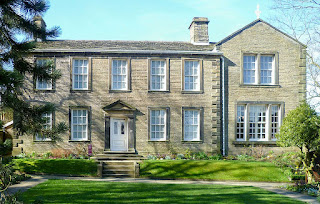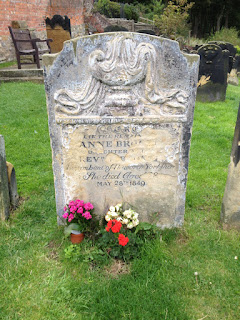I have always loved visiting the homes of famous writers in the hope that seeing where they lived and produced their work might somehow inspire me to become a better writer.
The Parsonage in Haworth, where the Brontë sisters
grew up, is now a museum celebrating their lives
When I visited the Brontë Parsonage Museum at Haworth I was fascinated to see where Charlotte, Emily, Anne and their brother, Branwell, grew up and did some of their best writing.
But it was purely by chance that I came to visit Anne Brontë’s grave in Scarborough one summer.
I was in the seaside resort with my husband who was there for work. I used to spend the day sightseeing while he was covering a cricket match for a newspaper.
We were staying on the North Cliff near the Castle and close to the churchyard of St Mary’s where Anne Brontë is buried.
There were signs directing visitors to the churchyard and it seemed almost discourteous not to go and pay my respects. The grave was easy to find close to the entrance and was marked by an additional stone, which had been recently added by the Brontë Society, correcting the author’s age at the time of her death.
Anne Brontë was just 29 when she died
 |
| Anne Brontë's grave in the churchyard of St Mary's Church in Scarborough |
Anne was the youngest child in her family, who was born to a clergyman and his wife on 17 January 1820. They moved to Haworth soon after her birth but her mother died before her second birthday.
Her eldest sisters, Maria and Elizabeth died at the ages of 11 and 10 respectively, after becoming ill at boarding school.
Charlotte and Emily were removed from the school and along with their brother, Branwell, the three girls were educated at home by their father and aunt.
Sisters drew inspiration from surroundings
There was little money and the sisters had to do their share of the domestic chores but they had access to their father’s books and periodicals, which they read avidly. There were few toys or treats, but a gift from their father to Branwell of a set of miniature soldiers led to the children creating a rich, imaginary world. Anne would have been six years old when she helped her brother and sisters write plays and stories about the lives of the soldiers. These were recorded in tiny, hand-written books that they produced for the soldiers to ‘read’.
When Charlotte went away to school again, Emily and Anne created another fantasy world of their own and continued to invent characters and stories for it until well into adulthood.
Nowadays we live far more comfortably and have many possessions and sources of entertainment, but these can also serve as distractions and stop us achieving things. Having so little in life made the Brontë children become inventive and they also drew inspiration from the moorland scenery and the architecture of the buildings near where they lived.
Governess work was sole career option
 |
| Charlottë Bronte found work as a teacher |
They all eventually found suitable situations with families, but in her first post Anne found the children particularly hard to control. She was eventually dismissed, which was traumatic for her, but she learned from her bad experiences and was able to reproduce them in her first novel, Agnes Grey.
Her second post as a governess proved more successful and the family took her on their annual holiday to Scarborough each year. She fell in love with the seaside resort, which inspired many of the locations in her novels.
When the Brontë sisters’ aunt died, they used some of the money they inherited from her to have their poems published under the pseudonyms, Currer, Ellis and Acton Bell.
Only two copies of the volume of poetry were ever sold, although Anne later succeeded in having some of her poems published in magazines.
Charlotte's first novel was rejected
But the sisters were not deterred and turned to novel writing instead. Amazingly, Charlotte’s first novel, the Professor, was rejected by every publisher she sent it to. She never let this put her off and started on her second novel, Jane Eyre, immediately. This was eventually accepted for publication and became an instant success.
Emily’s novel, Wuthering Heights and Anne’s first book, Agnes Grey, were both accepted straight away. Charlotte criticised the terms they were offered as they each had to contribute £50, which was to be refunded when a sufficient number of copies had been sold. History has proved the investment to be worthwhile, so take heart, all modern-day self publishers
Although ‘lady readers’ were warned against Wuthering Heights and Anne’s second novel, The Tenant of Wildfell Hall, because of their depictions of wild characters and violent scenes, the books continued to sell well.
Anne is now believed to be the first ‘feminist’ author, but she never received the recognition she deserved during her lifetime.
Branwell died suddenly in 1848 at the age of 31 and then both Emily and Anne were found to be suffering from tuberculosis. Emily died three months after Branwell at the age of 30.
Aware she was dying, Anne decided to visit Scarborough one last time, hoping the sea air would help her. In May 1849, accompanied by Charlotte and a friend, she travelled to Scarborough, where she died four days later.
Odds always stacked against Anne Brontë
 |
| Anne Brontë was determined to persevere with her writing |
Many people writing today may not be as talented or inventive as Anne Brontë, but if they are lucky enough to live long enough and prepared to work hard enough they at least have the chance to improve their skills. Ironically, we have easier lives than people in the 19th century, but perhaps this has made it harder for us to be disciplined or have the will to persevere with writing.
The odds were stacked against Anne Brontë as a writer from the moment she was born. As a woman she was considered to be a second class citizen and her writing was not taken seriously until she submitted it under a pseudonym. As the youngest in the family she was patronised by the other children and expected to be submissive.
But she was quietly determined and immensely self-disciplined and in her 29 years she managed to write two good novels and some powerful poetry.
In today’s climate of redundancy, women who have been pushed aside in the workplace and made to lose confidence should take heart from her and be inspired by her because if they are lucky to live long enough and prepared to work hard enough they may yet still achieve their ambitions.
It is claimed that Charlotte Brontë would not allow the reprinting of The Tenant of Wildfell Hall after her sister’s death and, lying in her cold grave in Scarborough, there was nothing Anne could do about it.
But like the error on her headstone, this was put right in time and Anne is now seen as not just a minor Brontë, but a major literary figure in her own right.
No comments:
Post a Comment